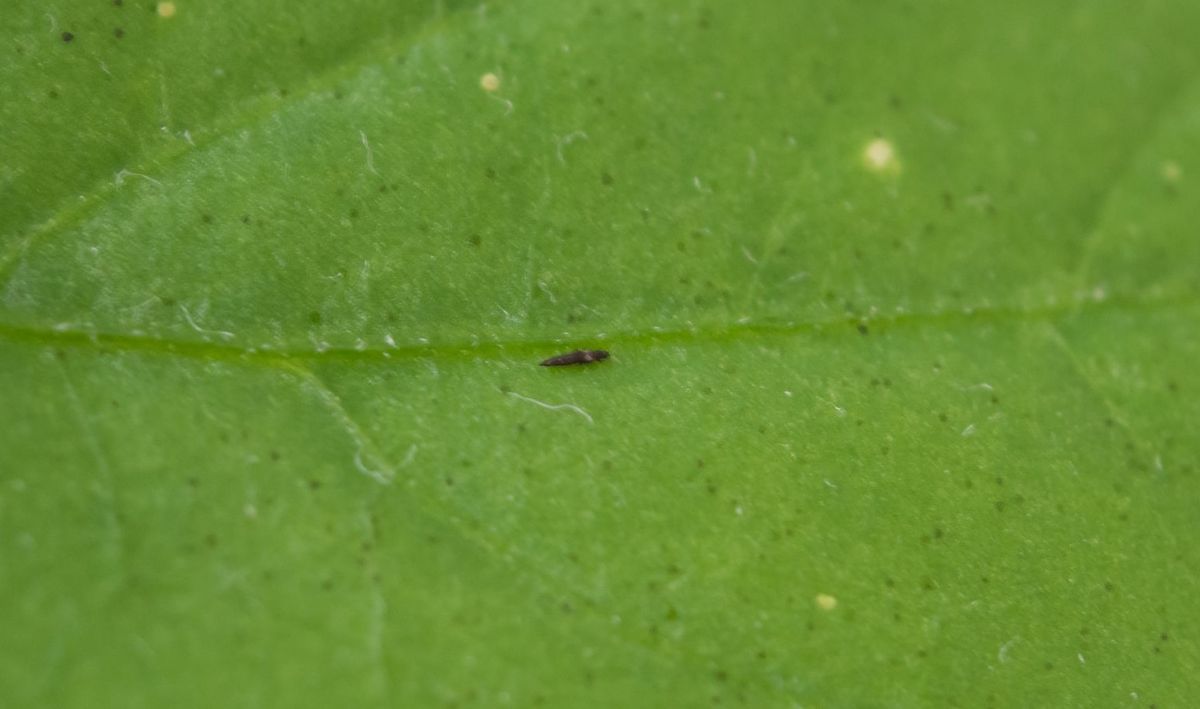Thrips
Thrips are tiny, needle-like insects that can cause significant damage to various plants in your garden.

These pests, which can be straw-colored to brown or black, belong to the Thysanoptera order, which includes over 5,000 species.
Identifying thrips requires keen observation, as their size and color can make them difficult to spot on plants.
Prevention, treatment, and control methods range from biological and organic pesticides to chemical control.
In this article, you'll learn how to identify thrips accurately, implement effective treatments, and prevent future infestations in your garden.
Thrips Identification
Identifying Thrips Species
To identify thrips species on your plants, look for tiny insects with needle-like bodies in colors ranging from yellow to black.
Their primary distinguishing features include fringed wings and minute mouthparts designed for sucking.
Check your plants for early signs of infestation, which often appear as spots, leaf damage, and scarred flowers.
To detect the presence of thrips more easily, place a white sheet of paper under the affected plant and gently shake it.
As thrips fall from the plant onto the paper, their dark bodies will be more visible.
Use a 10- to 15-power magnifying glass to get a closer look.

Understanding Thrips' Life Cycle
Knowledge of thrips' life cycle can be helpful for effective control and prevention strategies.
Thrips typically undergo five development stages: egg, two larval stages, pre-pupa, and adult. Adult thrips lay translucent eggs within plant tissue, making them difficult to spot.
Newly hatched larvae are wingless and feed on plant tissue, while adults possess the aforementioned fringed wings and continue to cause plant damage with their feeding.
Some species, like minute pirate bugs, are beneficial and feed on other pests, making proper identification crucial for ensuring a healthy garden environment.
Signs of Thrips Damage
Common Damages by Thrips on Plants
Thrips damage is often found on plant leaves, stems, and flowers.
You may notice stippling or discoloration in affected areas caused by the thrips feeding on plant sap.
Additionally, infested plants may exhibit a silvery appearance or distorted foliage due to the nymphs and adult thrips scraping plant tissue while feeding.
Particular Thrips Species Damage
Certain thrips species are vectors for plant viruses, such as the necrotic spot virus and tomato spotted wilt virus.
These viruses can cause severe damage to various plants, including vegetables and ornamentals.
Observing irregular growth patterns or unusual discolorations on your plants may be a sign of a virus transmitted by thrips.
Understanding Thrips Infestation
Thrips are tiny, slender insects that can cause significant damage to plants in agricultural fields and indoor houseplants.
An infestation occurs when these pests reproduce rapidly and feed on plant material, targeting leaves and flowers.
Thrips Breeding and Generations
Thrips go through several life stages - egg, larva, pupa, and adult. Adult females lay eggs in plant tissue, usually on leaves, where they hatch into larvae, causing damage by sucking plant sap.
After passing through the larval stages, they develop into pupae, typically in leaf litter or soil. Finally, they emerge as adult thrips, ready to breed and continue the cycle.
Their reproduction rates vary depending on species, but some common types, like citrus and western flower thrips, are known for their rapid generations.
This quick cycle allows infestations to spread swiftly, making it crucial to stay vigilant and implement effective prevention and control measures.
Regular monitoring, proper sanitation, and early intervention can help minimize damage to your plants and preserve their overall health.
Treating Thrips Infestation
Organic and Inorganic Treatments
To treat thrips infestations, you can use organic treatments such as insecticidal soaps and neem oil.
Apply these treatments to the affected plants, covering the whole plant, including stems, leaves, and buds.
Alternatively, you can opt for chemical pesticides, which should be used carefully to maintain the balance of the ecosystem and not harm beneficial insects.
Natural Predators for Control
In addition to these treatments, you can utilize natural predators to help control thrips populations.
Introducing lacewings (larvae and adults) and minute pirate bugs to your garden can significantly help reduce thrips infestations.
These predators target pests such as thrips and effectively control their population growth while protecting the environment.
How to Prevent Thrips Infestation
To prevent thrips infestation, you must keep your plants healthy and stress-free.
Regularly inspect leaves and stems for any signs of thrips, and take immediate action if you spot them.
Remove weeds from your garden, as they can serve as an alternate host for thrips, and use reflective mulch to reduce their ability to find your plants.
Incorporate proper pruning techniques to create airflow between plants, reducing humidity and deterring thrips.
Keep the area around your plants free from debris, and consider using sticky traps to monitor their presence.
For effective treatments, consider using insecticidal soap or neem oil to eliminate nymphs and adult thrips safely.
Apply these treatments early in the morning or late in the evening, when thrips are most active, for maximum effectiveness.
Thrips and Diseases
Thrips can transmit various viruses to plants, causing severe diseases and damage.
One common virus transmitted by thrips is the Tomato Spotted Wilt Virus (TSWV), which can lead to severe damage in plants, such as necrosis, stunted growth, and even plant death.
Another virus that thrips can carry and spread is the Impatiens Necrotic Spot Virus (INSV), which also causes necrosis and other symptoms in affected plants.
To prevent thrips-transmitted diseases, regularly monitor your plants for signs of thrips infestation and implement proper control measures, such as using insecticides or introducing beneficial insects like mites and aphids to counteract the population.
Conclusion
To protect your plants from thrips, it is essential to learn how to identify them and apply effective treatments.
Doing so can reduce and prevent damage caused by these tiny pests.
To manage thrips, consider using biological control methods or organic pesticides, which will minimize harm to beneficial insects and the environment.
You can maintain a healthy and thriving garden with vigilance and proper care.
Frequently Asked Questions
What are the signs of thrips damage?
Thrips damage can appear as small, discolored spots or streaks on leaves, buds, and flowers. Additionally, you may notice a distorted growth or a silvery appearance on the affected plant parts.
How can thrips be identified?
Thrips are tiny, needle-like insects that are difficult to spot with the naked eye. You can use a magnifying glass to examine leaves and flowers for their presence or tap the affected plant part over a white paper to reveal any dislodged thrips.
Which treatments are most effective for thrips?
Chemical pesticides can control thrips, but choosing products specifically designed for management is essential. Always follow the manufacturer's instructions and apply pesticides safely to avoid harming beneficial insects and the environment.
What natural methods can help control thrips?
Cultural practices such as regular pruning and removing infected plants can help prevent thrips infestation. Organic pesticides like neem oil or insecticidal soaps can also be a more environmentally friendly option to manage thrips populations.
Which biological controls are ideal for thrips management?
Predatory insects like ladybugs, lacewings, and minute pirate bugs are effective biological control agents for managing thrips. Introducing these beneficial insects to your garden or greenhouse can help control thrips naturally and minimize the need for chemical insecticides.


